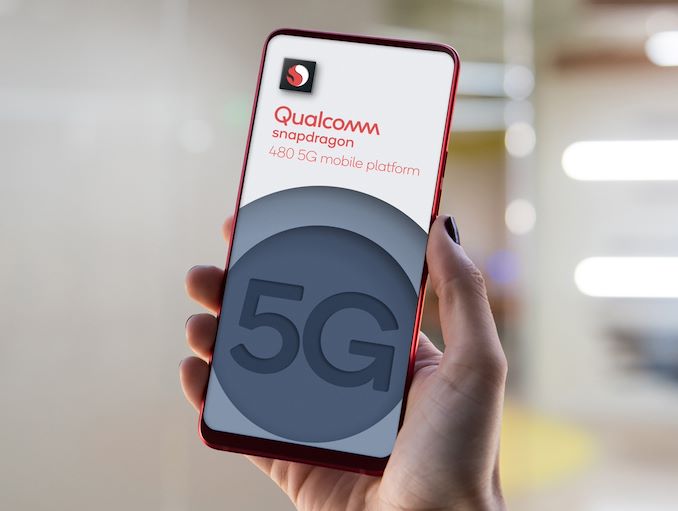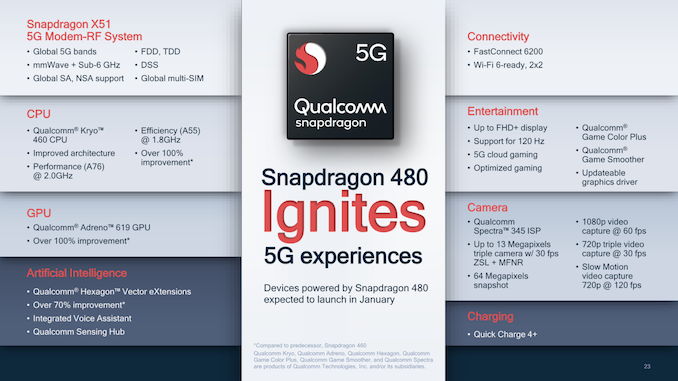Qualcomm Announces Snapdragon 480 - First 5G Low-end SoC
by Andrei Frumusanu on January 4, 2021 9:30 AM EST- Posted in
- Mobile
- Qualcomm
- Smartphones
- SoCs
- Snapdragon 480

Today Qualcomm is making a big step towards enabling wide-spread adoption of 5G through the announcements of the new Snapdragon 480 low-end 5G SoC. The company had already alluded a few months ago that it would be releasing a Snapdragon 400-series design with 5G compatibility, bringing the new connectivity standard to the lowest-cost devices of the market, targeting the very high volume $250 price range.
The new Snapdragon 480 is an extremely impressive SoC not merely because of its 5G feature list, but also because it’s a major performance upgrade in many aspects, including the use of two Cortex-A76 cores as its main performance CPUs – a very large jump in the 400 series family, likely representing a major leap in performance for millions of low-cost devices in the market.
| Qualcomm Snapdragon 400-Range SoCs | |||||||
| SoC | Snapdragon 439 | Snapdragon 450 | Snapdragon 460 |
Snapdragon 480 |
|||
| CPU | 4x CA53 @ 2.2GHz 4x CA53 @ 1.7GHz |
8x CA53 @ 2.3GHz |
4x Kryo 240 (CA73) @ 1.8GHz 4x Kryo 240 (CA53) @ 1.8GHz |
2x Cortex-A76 @ 2.0GHz 6x Cortex-A55 @ 1.8GHz |
|||
| GPU | Adreno 505 | Adreno 506 | Adreno 610 | Adreno 619 | |||
| DSP | Hexagon 536 | Hexagon 546 | Hexagon 683 | Hexagon 686 | |||
| ISP/ Camera |
Spectra 21MP single 8MP dual |
Spectra 21MP single 13MP dual |
Spectra 340 36MP single 22MP dual |
Spectra 345 64MP single 25+13MP dual 13MP triple |
|||
| Encode/ Decode |
1080p30 H.264 |
1080p60 H.264 & H.265 |
|||||
| Memory | 1x 32-bit @ 933MHz LPDDR3 7.4GB/s |
2x 16-bit @ 1866MHz LPDDR4X 14.9GB/s |
2x 16-bit @ 2133MHz LPDDR4X 17.0GB/s |
||||
| Integrated Modem | Snapdragon X6 LTE (Category 4/5) DL = 150Mbps 2x10MHz CA, 64-QAM UL = 75Mbps 1x10MHz CA, 64-QAM |
Snapdragon X9 LTE (Category 7/13) DL = 300Mbps 2x20MHz CA, 64-QAM UL = 150Mbps 2x10MHz CA, 64-QAM |
Snapdragon X11 LTE (Cat 12/13) DL = 390Mbps 2x20MHz CA, 256-QAM UL = 150Mbps 2x20MHz CA, 64-QAM |
Snapdragon X51 LTE DL = 800Mbps UL = 210Mbps 5G NR sub-6 + mmWave (100 + 200MHz) DL = 2500Mbps UL = 660Mbps |
|||
| Mfc. Process | 12nm LPP | 14nm LPP | 11nm LPP | 8nm LPP | |||
Starting off with the CPU configuration, the new Snapdragon 480 is pretty exciting for a SoC in the low-end, as it ditches the older Cortex-A73 cores of the previous generation Snapdragon 460 for a pair of newer Cortex-A76 cores, running at 2.0GHz. This isn’t the newest CPU IP on the market, however the jump from an A73 to an A76 is extremely large in terms of single-threaded performance, and is set to bring significant user experience benefits for new devices using the Snapdragon 480. The new SoC is a 2+6 CPU design, unlike the 4+4 setup of its predecessor – multi-threaded performance might not see as large a bump, but for this class of SoC I don’t see that as being an issue. The CPU configuration actually looks almost identical to what we’ve seen on the Snapdragon 675 – those parts would be good indicators of what to expect from the new 480 design.
On the GPU side of things, we’re seeing an upgrade from an Adreno 610 to an Adreno 619 – Qualcomm here promises a 100% increase in performance over its predecessor in the Snapdragon 460.
On the memory side of things, this is still a low-cost 2x16b LPDDR4X SoC, however we’ve seen a slight boost in frequencies to 2133MHz.
AI performance is said to be increased by 70%, partly due to the upgrade to a new Hexagon 686 DSP block with vector and tensor extensions. Interestingly on the camera side of things, Qualcomm quotes that they’ve actually implemented a triple-ISP system, a feature that was only recently announced in the flagship Snapdragon 888 a few weeks ago. The maximum sensor resolutions lie in a 64MP for a single module, 25+13MP in dual-camera mode, or 13+13+13MP in triple-sensor capture mode.
Oddly enough even though the ISP capabilities have grown this generation, the video encoder is still only limited to 1080p60 H.264/H.265. Qualcomm also discloses that the display controller maxes out at 1080 x 2520, although it supports refresh rates up to 120Hz.
5G in the low-end
Although the Snapdragon 480 would have been impressive just with the aforementioned specification upgrades, the big feature of the new generation SoC is its new modem subsystem which fully supports 5G NR.
The integrated X51 modem supports LTE up to 800Mbps downlink and 210Mbps uplink, as well as combined 5G sub-6 and mmWave throughput of up to 2500Mbps downlink and 660Mbps uplink. Sub-6GHz spectrum capability falls in at 100MHz, but what’s very surprising to see is that even though the chipset is a low-end low-cost design, it still features mmWave capabilities – albeit with a much smaller spectrum bandwidth compared to the larger flagship modems, falling in at only 200MHz. Given that currently in the US mmWave plays an important marketing role in 5G deployments, having any support for the new technology is a must to be able to get device design wins, even though it’s a bit of a contradictory feature to have in low-end cost-sensitive devices.
The X51 modem is capable all new important 5G technologies, supporting FDD and TDD standalone (SA) and non-standalone (NSA) 5G networks, as well as DSS (Dynamic Spectrum Sharing).
Then new chip is manufactured on Samsung’s 8nm process node, which should give it very good power efficiency.
Partner vendors included in Qualcomm’s announcement included HMD Global, OPPO and Vivo, endorsing the new chipset. More interestingly, OnePlus was also amongst the vendors to be note the new chipset - maybe that signals the arrival of a new low-end OnePlus device?
Qualcomm expects the first Snapdragon 480 devices to be announced this month.
Related Reading:
- Qualcomm Announces Snapdragon 750G: Cortex-A77 & mmWave in the Premium Range
- Qualcomm Announces Snapdragon 732G: 730G Gets a Speed Bump
- Qualcomm Announces Snapdragon 690: 5G & A77 In The Mid-Range
- Qualcomm’s New 3rd Generation Snapdragon X60 5G Modem, Built on 5nm
- Qualcomm Announces Snapdragon 720G, 662 and 460 SoCs











26 Comments
View All Comments
akmittal - Monday, January 4, 2021 - link
This seems great but I think most OEMs go for mediatek.Qualcomm seriously needs a good competitor in high performance. M1 performance is just bonkers.
uzzi38 - Monday, January 4, 2021 - link
No stock ARM core even gets close to Firestorm, and looking at ARM's future roadmap there won't be for a long time unless you design your own ARM core instead.That's what QC would have to do to compete with Apple's single-threaded performance.
Also QC are really competing with A14, not M1. QC are showing no sign of caring significantly about WoA, we'll have to hope some other ARM vendor does instead.
akmittal - Monday, January 4, 2021 - link
Qualcomm design their custom kryo cores.Even comparing with A14 there is single core difference of 30-40%
arayoflight - Monday, January 4, 2021 - link
The last custom Kryo core was in Snapdragon 820. Since then it's all been just rebranding Cortex cores as Kryo.lmcd - Tuesday, January 5, 2021 - link
Yes and that core was a whole fiasco, as it's the only ARM64 Qualcomm design no longer supported by the Windows kernel.iphonebestgamephone - Tuesday, January 5, 2021 - link
What device ran windows on the 820?iphonebestgamephone - Tuesday, January 5, 2021 - link
Oh, the alcatel idol 4s. So it got updates up until the support was stopped?spaceship9876 - Monday, January 4, 2021 - link
I'm pretty sure they just modify the arm cores by changing cache sizes or something not creating their own cores from scratch.nandnandnand - Monday, January 4, 2021 - link
Throw two X1s and 14 other cores in a SoC, and you have something that will work well for WoA. It doesn't have to be as good as Apple M1.fishingbait - Monday, January 4, 2021 - link
"No stock ARM core even gets close to Firestorm"Huh? Cortex X1 doesn't get close to Firestorm? Got a link to prove this?